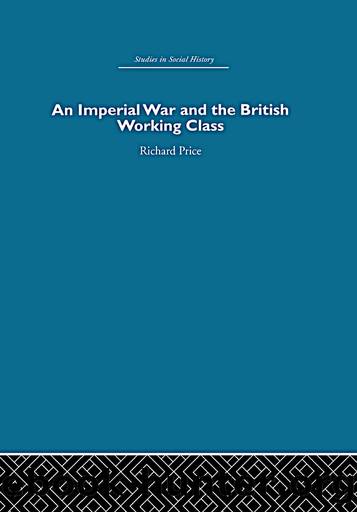An Imperial War and the British Working Class by Richard Price

Author:Richard Price [Price, Richard]
Language: eng
Format: epub
Tags: History, General, Reference
ISBN: 9781134529780
Google: ybpYAQAAQBAJ
Publisher: Routledge
Published: 2013-10-15T01:19:29+00:00
The same sort of evidence is rarer for the rest of the country. It has already been noted how the students at Birmingham were âcredited with the intention of joining the throngâ,75 and there is little reason to doubt that they did attend. In London the Stock Exchange element was sometimes prominent. This may have been true at the Trafalgar Square demonstration of 24 September 1899. Club Life reported how âit was noticed by reporters that the noise and disturbance was created by young clerks, medical students and beardless youthsâ.76 The Star commented on âthe band of boys in straw hats and high collars . . . [who] are probably too young to remember some earlier scenes in Trafalgar Squareâ.77 But of the six arrested on this occasion none was a clerk as far as is knownâtwo were not listed as having any occupation in the newspaper report and the other four were all young manual workers.
This, however, was not always the pattern at the London meetings. The aforementioned Merriman and Sauer meeting showed a very different result. It has already been noted how the Stock Exchange was accused of âplottingâ to disturb this meeting. The Morning Leader asserted that the rowdies were âthe Stock Exchange gangs who were present in response to ordersâ.78 Of the seven arrested for causing a disturbance outside the Queenâs Hall on this occasion three were clerks, two of whom were from the Stock Exchange. Of the four others arrested, two were working-classâa porter and a whip-maker; and two were middle-classâa medical student and the son of the proprietor of the People and the Globe.79
One final example of middle-class group âleadersâ as characteristic of the jingo crowd can be examined. W. T. Stead, at the beginning of the war, as a part of his War Against War crusade, addressed several meetings including one at Norwich on 5 November 1899. It was an unsuccessful gathering, broken up by rowdyism created and led by âhalf-a-dozen scions of successful traders or professional menâ. These young men were known as the âyoung lionsâ of Norwich. They were a well-known set and comprised the sons of leading solicitors in the town including Edward Bullard, the son of the junior member of parliament for the city. A reporter was
struck by the strength of representation which the legal profession had. Foremost in the fray was Mr. Gilbert Kennett, and in the busiest parts of the building I noticed Mr. Emerson Jr., Mr. Cooper Jr., Mr. Orams Jr., and a Mr. Martin, who I believe, is associated in some way with Messrs. Cozens-Hardy and Jewison an important law firm in the town.
Stead was greeted with an outburst of yells from the âyoung lionsâ when he rose to speak. A show of hands to hear him was claimed to be âabout four to one in favourâ but when he tried again, âhowling, yelling, cat-calls, abuse, and noisy demonstrations from some squeaking instrument . . . rendered it impossible to hear a wordâ. Led by Bullard, the âyoung lionsâ then stormed the platform and captured the meeting.
Download
This site does not store any files on its server. We only index and link to content provided by other sites. Please contact the content providers to delete copyright contents if any and email us, we'll remove relevant links or contents immediately.
| Central Africa | East Africa |
| North Africa | Southern Africa |
| West Africa | Algeria |
| Egypt | Ethiopia |
| Kenya | Nigeria |
| South Africa | Sudan |
| Zimbabwe |
Goodbye Paradise(3730)
Men at Arms by Terry Pratchett(2784)
Tobruk by Peter Fitzsimons(2447)
Arabs by Eugene Rogan(2263)
Borders by unknow(2232)
Pirate Alley by Terry McKnight(2187)
Belonging by Unknown(1813)
It's Our Turn to Eat by Michela Wrong(1688)
The Biafra Story by Frederick Forsyth(1617)
Botswana--Culture Smart! by Michael Main(1560)
The Source by James A. Michener(1541)
A Winter in Arabia by Freya Stark(1506)
Coffee: From Bean to Barista by Robert W. Thurston(1489)
The Falls by Unknown(1488)
Gandhi by Ramachandra Guha(1488)
Livingstone by Tim Jeal(1453)
The Shield and The Sword by Ernle Bradford(1369)
Africa: Altered States, Ordinary Miracles by Richard Dowden(1353)
Egyptian Mythology A Fascinating Guide to Understanding the Gods, Goddesses, Monsters, and Mortals (Greek Mythology - Norse Mythology - Egyptian Mythology) by Matt Clayton(1331)
